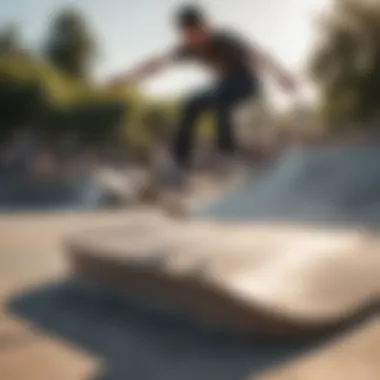Skateboarding Basics: A Comprehensive Guide


Intro
Skateboarding has transcended its origins as a mere pastime for youth. It has become a cultural phenomenon, a sport, and a lifestyle embraced by millions worldwide. Understanding the foundations of skateboarding is essential for those who wish to engage deeply with this exhilarating activity. Not only does it entail mastering various techniques, but it also encompasses knowledge of safety measures, equipment, and the cultural influences that shape the sport. This exploration aims to provide a holistic view of skateboarding, guiding both newcomers and advanced practitioners toward a comprehensive understanding of its fundamentals.
The History of the Sport
Origin and Evolution
The roots of skateboarding can be traced back to the late 1940s and early 1950s in California, where surfers sought a way to 'surf' on land during times when the waves were too weak. Initially, these skateboards were made from wooden planks with roller skate wheels attached. Over the years, innovations in design evolved the skateboard into a more functional and versatile tool. This period marked the beginning of skateboarding as both a recreational and competitive sport.
Milestones and Influences
Key historical moments have significantly shaped skateboarding. The introduction of urethane wheels in the 1970s transformed the sport, allowing for smoother rides and better control. The first skateboarding competitions in the mid-1970s also provided a platform for skateboarders to showcase their skills. The emergence of skate parks further spurred interest and development, becoming an essential element of skateboarding culture.
Key Athletes and Pioneers
Pioneers like Tony Hawk, who started their careers in the 1980s, have influenced the sport's evolution. Hawk's feats introduced new tricks and expanded the limits of what was possible on a skateboard. Other notable athletes, including Rodney Mullen and Stacy Peralta, have contributed significantly through their innovations in styles and techniques, making skateboarding the dynamic sport we see today.
Techniques and Skills
Basic Techniques for Beginners
For newcomers, mastering basic techniques is crucial. Learning to push off, balance, and turn are fundamental skills that form the foundation for more advanced moves. These skills include:
- Proper stance and foot placement
- Pushing off with the back foot
- Carving and turning skillfully
Advanced Skills to Acquire
Once the basics are ingrained, skateboarders can progress to advanced tricks such as:
- Ollies and kickflips
- Grinds on rails and ledges
- Aerial maneuvers like the 720 or the McTwist.
These skills require dedication, practice, and sometimes a little falling.
Common Mistakes and How to Avoid Them
Even experienced skateboarders can make errors that hinder progress. Common mistakes include:
- Poor foot placement leading to loss of balance
- Inadequate attention to surroundings while skating
By focusing on safe practices and improving technique, these issues can be minimized.
Safety Measures
Essential Safety Gear
Wearing proper safety gear is non-negotiable. The right equipment includes:
- Helmets to protect the head
- Knee and elbow pads for joint safety
- Wrist guards to prevent injuries during falls
Safety Practices and Procedures
Skateboarding is inherently risky, and understanding safety practices is vital. Always inspect your equipment before riding. Use designated skate parks rather than busy streets when possible, and be aware of your environment to avoid accidents.
How to Prepare for Unexpected Situations
Skateboarders should maintain a level of preparedness for unforeseen events. Carry a basic first-aid kit, know how to assess injuries, and learn essential emergency contact numbers. Understanding how to manage risks can make skating a safer experience.
Gear Recommendations
Top Brands and Products
Choosing the right skateboard can enhance performance and enjoyment. Brand names like Element, Santa Cruz, and Anti-Hero are reputable in the community for their durability and quality.
Budget vs. Premium Options
While premium boards offer enhanced performance, budget options exist for beginners. Brands such as Powell Peralta provide accessible choices without compromising too much on quality.
Maintenance and Care for Gear
Proper maintenance prolongs the life of skateboards. Regularly check hardware for looseness. Clean your wheels and bearings to prevent long-term damage, and store your skateboard in a dry place to reduce wear.
"Safety and proper technique are the cornerstones of enjoying skateboarding to its fullest."
Preamble to Skateboarding
Skateboarding serves as an intriguing blend of sport, art, and expression. It offers not only a means of transportation but also a way to engage in a vibrant culture. This article aims to dissect the intricacies of skateboarding, making it accessible for both newcomers and seasoned enthusiasts alike. Understanding the essentials allows for a safer and more enjoyable experience.
In this section, we will touch on the historical context and the significance of skateboarding in modern society. As we examine the evolution and its cultural impact, it becomes evident that skateboarding is more than just a hobby—it's a lifestyle embraced by diverse communities worldwide.
The Evolution of Skateboarding


Skateboarding traces its roots back to the late 1940s, originating from surfers who wanted to mimic their riding technique on land. The first skateboards were simple wooden planks with roller skate wheels attached. Over the years, the sport has evolved significantly into various styles and subcultures. By the 1970s, innovations in skateboarding equipment, such as the advent of the polyurethane wheel and improved board designs, contributed greatly to its growth.
New styles emerged, like vert skateboarding, characterized by performing tricks on half-pipes, and street skating, which utilizes urban obstacles. Each style reflects the creativity and adaptability of skateboarders, who continuously redefine the boundaries of the sport.
Why Skateboarding Matters
Skateboarding holds a unique place in the world of sports and youth culture. It plays a significant role in promoting physical activity, helping to develop balance, coordination, and resilience. It's a medium for self-expression and creativity, allowing individuals to showcase their unique style and personality through tricks and movements.
Moreover, skateboarding fosters community. Local skate parks often serve as gathering places where riders of different backgrounds come together, share tips, and encourage one another. The camaraderie built within these spaces contributes to a sense of belonging and mutual respect among skateboarders.
Essential Skateboarding Gear
Selecting the right gear is fundamental to the skateboarding experience. Proper equipment not only enhances performance but also prioritizes safety. Understanding the types of skateboards and the necessary protective gear can significantly impact a skater's skill progression and enjoyment.
Choosing the Right Skateboard
Choosing the appropriate skateboard is crucial for every skater. Each skateboard serves different purposes and caters to various styles.
Types of Skateboards
Types of skateboards can vary widely, including street, cruiser, and longboards. Each type brings unique advantages. For instance, street skateboards are best for performing tricks and navigating urban environments. Cruisers, with their wider decks, offer a more comfortable ride for casual skating. Longboards are designed for stability and speed, suitable for downhill riding.
Key characteristics to consider include deck shape and wheel size. The flat and concave shapes allow for better trick execution. These features make street skateboards a very popular choice among skateboarders.
Deck Material and Size
Deck material and size influence both durability and performance. Most decks are made from maple wood, which provides a good balance of strength and flexibility. However, some decks now use materials like bamboo or composite materials. The choice of a larger deck offers more stability, though it may limit tricks.
The width and length are also vital; a wider deck can support more foot placement. In contrast, narrower options allow for technical tricks. Each material has its advantages; however, wood remains the standard for most skaters.
Wheel Hardness and Size
Wheel hardness and size are essential for controlling speed and maneuverability. Softer wheels, typically durometer 78A-87A, provide a smoother ride on rough surfaces. Conversely, harder wheels, rated from 88A and above, are great for smooth surfaces.
Smaller wheels offer a lower center of gravity, beneficial for tricks, while larger wheels help maintain speed on rough terrains. Choosing the right hardness and size is essential for comfort and grip.
Protective Gear Overview
Safety should always come first in skateboarding. Protective gear minimizes the risks associated with falls and injuries.
Helmets and Safety Standards
Helmets are crucial for protecting the head from impact. It is important to choose helmets that meet safety standards, such as CPSC or ASTM. A well-fitted helmet not only provides safety but also enhances confidence while skating.
Varying styles and colors are available, allowing skaters to express their personality. Most helmets are lightweight and ventilated, adding comfort during use. However, finding the right balance between style and safety is key.
Knee and Elbow Pads
Knee and elbow pads provide added protection against abrasions and impacts. These pads help absorb shock during falls, reducing the risk of injury. Various designs and sizes are available, ensuring a snug fit.
Users often prefer pads that offer flexibility and comfort so they can skate without restrictions. While they add some bulk, the benefits often outweigh the downsides.
Footwear Considerations
Footwear plays a vital role in delivering the right grip and support. Skate shoes are designed specifically for this purpose, featuring flat soles for better board feel. Additionally, reinforced areas like the toe cap add durability.
Popular brands like Vans and Nike SB offer shoes tailored for skaters. However, wearing regular sneakers may not provide the necessary grip and support. Selecting proper footwear can significantly impact performance on the board.
Fundamental Skateboarding Techniques
Understanding the fundamental skateboarding techniques is crucial for anyone looking to improve their skills and enjoy the sport. These techniques are the building blocks that enable skaters to navigate various terrains and perform tricks effectively. Mastering them can greatly enhance one’s confidence and overall skating experience. Each technique contributes not only to the performance but also to the safety and control of the skateboarder.
Stance and Balance
Regular vs. Goofy Stance
The choice of stance is essential for comfort and control during skating. The regular stance means left foot forward, while the goofy stance is right foot forward. This aspect is significant for personal preference and stability. Skaters often choose their stance based on which foot feels more natural when pushing off.
Key characteristic of each stance lies in its influence on balance. For instance, regular stance is commonly preferred due to its prevalence among skaters. However, goofy stance offers its own advantages, particularly for individuals who begin right-footed.
Unique features include how each stance affects a skater’s ability to perform tricks. Regular stance skaters typically find it easier to learn certain moves. Conversely, goofy skaters may excel in tricks that require rotation to the right.
Finding Your Balance
Balance is critical in skateboarding. It allows the skater to maintain control while moving. Learning to find balance means understanding body positioning over the skateboard. The ability to shift weight smoothly can determine overall performance in various techniques.
The key characteristic of finding balance is discovering what feels right for your body. Whether leaning forward or backward, each skater will have their unique point of equilibrium. This aspect is crucial for beginners who may struggle initially.
A unique feature includes how balance can be developed through practice. As skaters become familiar with their board, they can learn to adjust their weight according to speed and angle.
Pushing Off and Rolling
Pushing off properly provides the momentum needed to gain speed. For beginners, learning to push off involves keeping the front foot on the skateboard while using the back foot to propel forward. This technique is the gateway to mastering various skating styles. It establishes initial balance and speed, both of which are necessary for effective skating. Practice helps solidify this technique, enabling smoother transitions into rolling.


Turning Techniques
Carving
Carving refers to the method of making sharp turns by angling the board. It is a fundamental skill that enhances control during movement. The key characteristic of carving is the ability to lean on the edges of the skateboard. This technique allows skaters to navigate through various terrains with agility.
Carving is beneficial because it promotes fluid movement, making it easier to maintain speed while turning. However, it requires practice to master, as improper technique can lead to loss of control.
Power Slides
Power slides are advanced techniques used primarily for braking. This method involves sliding the board sideways, allowing the skater to reduce speed quickly. The key characteristic of power slides lies in the balance between control and speed. This technique is popular among more experienced skaters due to its dramatic effect.
Unique features include its ability to be executed on various surfaces. Power slides can be performed on concrete, pavement, or any smooth surface. However, they require significant practice to ensure safety and control.
Mastering fundamental skills such as stance, balance, and turning techniques lays the groundwork for excelling in skateboarding. Each element interlinks, creating a framework that promotes both skill and safety.
Safety Measures for Skateboarding
Skateboarding, while thrilling, comes with its own set of risks. Understanding safety measures is essential for anyone who enjoys this sport. Proper safety practices protect individuals from injuries, making the skateboard more enjoyable. Knowing potential dangers and best practices ensures a safer ride for skaters.
Understanding Common Injuries
Injuries in skateboarding can range from minor to serious. Often seen are scrapes and bruises that result from falls. However, more severe injuries, such as fractures or concussions, also occur.
Common injuries include:
- Wrist fractures: Falling with arms extended often causes damage to the wrist.
- Ankle sprains: Uneven landings can lead to twisted ankles.
- Cuts and abrasions: Skin contact with rough surfaces brings about numerous surface injuries.
- Head injuries: Without proper helmets, head injuries like concussions can happen, even from minor falls.
Realizing the types of injuries can help skaters take precautions. Wearing appropriate gear and knowing one’s surroundings can significantly reduce these risks.
Tips for Safe Skateboarding
Skating safely requires more than just wearing a helmet. It involves choosing the right environment and being aware of conditions that can affect safety.
Skating in Safe Areas
Choosing safe locations for skating plays a vital role in minimizing injuries. Skate parks are designed specifically for this purpose. They provide various surfaces, ramps, and features for skaters, reducing the risks of collisions with vehicles or pedestrians.
Key characteristics of safe areas include:
- Designed features for skating: Includes ramps, rails, and bowls specifically meant for tricks and skating.
- Visibility: Open spaces make it easier to see potential hazards and adapt accordingly.
While public streets can also be skateboarding spots, they typically pose more dangers due to traffic. Using dedicated skate parks allows skaters to focus on developing their skills without worrying about external factors.
Weather Considerations
Weather plays a significant role in skateboarding safety. Wet or icy conditions can cause a skater to lose control, leading to falls. Checking the weather before heading out can prevent accidents.
Some characteristics influencing skateboarding during various weather include:
- Wet surfaces: Rain makes roads slippery, increasing the chance of falls.
- Wind: Strong gusts can affect balance and control over the skateboard.
Planning skate sessions around favorable weather not only improves safety but also enhances performance. Being cautious of the environment can significantly benefit overall skating experience.
Exploring Skateboarding Styles
Exploring the diverse styles of skateboarding is essential for a comprehensive understanding of the sport. Each style carries its own techniques, culture, and followers, which contribute to the richness of skateboarding as an activity. Whether one is drawn to the urban landscape, the gravity-defying heights of ramps, or the smooth rides of longboards, each skating style offers unique benefits. Understanding these differences can enhance performance and help skateboarders find their niche within the vast world of skateboarding.
Street Skateboarding
Overview of Street Culture
Street skateboarding is deeply rooted in urban environments. It focuses on the interaction between skateboarders and the city landscape. This style allows riders to use everyday structures as their playground. Such as stairs, benches, and handrails. The key characteristic of street skateboarding is its reliance on creativity. Every skater can create their own style based on the elements found in their surroundings. This makes it a popular choice among skateboarders, fostering a sense of individuality.
The unique feature of street culture is its accessibility. Almost anyone can start skating in their local area without needing specialized equipment or facilities. However, the urban environment also poses challenges. Skaters often deal with obstacles like traffic, pedestrians, and legal restrictions. This requires careful planning and awareness, making street skating both exhilarating and risky.
Common Tricks
Common tricks form the foundation of street skateboarding. They include maneuvers such as ollies, kickflips, and grinds. Each trick requires specific skills and understanding of balance. Learning these tricks is essential for progressing in this style. The key characteristic of these tricks is their versatility. From amateur skaters to seasoned pros, everyone incorporates them into their routine. This widespread appeal makes them beneficial for building a broad skill set.
Common tricks also feature unique challenges. Mastering them demands time and practice. Skateboarders may face frustration along the way as some tricks can take considerable effort to perfect. But the satisfaction gained from achieving a new trick is often fulfilling, contributing to personal growth.
Vert and Park Skateboarding
Ramp Designs
Ramp designs play a crucial role in vert and park skateboarding. They influence the type of tricks skaters can perform. Ramps can come in various shapes and sizes, including halfpipes and quarterpipes. Each ramp design offers distinct challenges and opportunities. The key characteristic of ramps is their ability to facilitate aerial maneuvers. This is particularly appealing for those who enjoy getting airborne.
The unique feature of ramp designs is their ability to accommodate multiple skill levels. Beginners can practice lower jumps, while advanced skateboarders can push their limits with complex tricks. However, skateboarding on ramps also comes with its set of risks. Falling from significant heights can lead to serious injuries without proper protective gear. Therefore, understanding ramp design is crucial for safety and skill progression.
Essential Techniques


Essential techniques in vert and park skateboarding are paramount for successful navigation of ramps. Techniques like pumping and carving enable skaters to maintain speed and control while performing tricks. The key characteristic of these techniques is their impact on flow and rhythm in skateboarding. They create a seamless experience as skaters transition between ramps.
They also offer a unique advantage. Mastering these techniques allows skaters to move fluidly and link tricks together. This can enhance the aesthetic quality of their skateboarding. However, these techniques often require consistent practice. Early on, skaters may struggle with coordination and timing. Overcoming these challenges is vital for progression in vert and park skateboarding.
Freestyle and Longboarding
Characteristics of Freestyle
Freestyle skateboarding emphasizes tricks performed on flat ground. This style is known for requiring balance and precise footwork. The key characteristic of freestyle is its diversity, with tricks ranging from simple spins to complex combinations of flips and slides. It is popular due to its creative freedom, allowing skaters to express themselves distinctly.
The unique feature of freestyle is that it encourages innovation. Skaters can develop their unique tricks and styles, enhancing their engagement with the sport. However, this freedom can also lead to frustration. Some tricks can be challenging to master, requiring patience and persistence.
Longboarding Dynamics
Longboarding dynamics refer to how this style functions on various terrains. Longboards are designed for stability and ease of use, making them suitable for cruising down hills or commuting. The key characteristic of longboarding is its focus on smooth rides and flowing movements rather than tricks. This makes it an excellent choice for those looking for a more relaxed experience on a skateboard.
The unique feature of longboarding is its emphasis on distance and comfort. Longboards can allow riders to travel longer distances with less effort. However, the drawback is that it may not provide the same thrill as trick-oriented styles. Riders looking for adrenaline might find it lacking. Ultimately, longboarding offers a different but equally valid approach to skateboarding.
Progressing in Skills
Progressing in skills is a critical aspect for anyone involved in skateboarding. It is not just about learning to ride; it is about mastering techniques and pushing personal limits. This journey enhances confidence and fosters a connection with the sport. Setting tangible goals and practicing effectively can maximize growth, making skating more enjoyable and fulfilling.
Setting Skill Goals
Setting skill goals provides a roadmap for your skateboarding journey. It helps prioritize what techniques to learn and track improvement. Goals should be specific, measurable, attainable, relevant, and time-bound (SMART). For example, instead of merely wishing to "get better," one might aim to perfect the ollie within a month. Goals can be categorized into short-term and long-term accomplishments.
Long-term goals could include mastering advanced tricks, while short-term goals might focus on specific techniques or increasing consistency. Each accomplishment, regardless of size, contributes to overall skill enhancement and motivates continuous practice.
Practicing Techniques
Practicing techniques is vital for skill improvement. Regularly dedicating time to push skills can lead to significant development. Two categories often addressed in practice are drills for beginners and advanced tricks and maneuvers.
Drills for Beginners
Drills for beginners lay the foundation for future advancement. Basic exercises help with balance, turning, and stopping. Key characteristics include focusing on fundamental movements, which cater to new skaters. It is a beneficial choice for developing core competency before tackling complex techniques.
One unique feature of beginner drills is their simplicity, allowing skaters to work on skills without overwhelming themselves. These drills can be practiced on various surfaces, which aids in improving adaptability. Their limitations include a steep learning curve for some skaters, as they may feel stagnant without visible progress.
Advanced Tricks and Maneuvers
Advanced tricks and maneuvers represent the apex of skill in skateboarding. These include but are not limited to flips, spins, and grinding. The key characteristic of these techniques is their complexity and the high level of control required. They can be a popular choice among seasoned skateboarders looking to showcase their abilities.
The unique features of advanced tricks often involve utilizing specific skateboarding gear suited for high-impact maneuvers. The rewards can be substantial, offering a sense of achievement and the potential for participation in competitions or exhibitions. However, they also carry the risk of injury, thus requiring proper techniques and safety precautions.
"Progressing in skills is not just a path, it’s essential to understanding the very essence of skateboarding."
Skateboarding Community and Culture
The skateboarding community and culture are vital pillars of the sport, contributing significantly to its evolution and acceptance worldwide. Skateboarding is not merely a sport; it is a lifestyle that promotes creativity, individuality, and camaraderie. Understanding the dynamics of this community offers essential insights into what makes skateboarding a unique experience for many.
The Role of Skate Parks
Skate parks function as the epicenter of skateboarding culture. These spaces are designed for skaters of all skill levels to practice and showcase their abilities. Skate parks often include ramps, rails, and bowls, each catering to different skating styles, from street skating to vert.
The communal atmosphere of a skate park fosters connection among skaters. It provides a safe environment where individuals can share tips, learn from one another, and encourage peers. Regular gatherings at these parks help forge friendships that extend beyond the sport itself, contributing to lasting bonds and a supportive network. Moreover, skate parks often host workshops and events, promoting skill development and introducing new skaters to the community. The accessibility of these parks gives rise to inclusive skating culture.
Events and Competitions
Events and competitions play a crucial role in the skateboard community. They serve not only as a platform for skaters to display their skills but also as a means of celebrating the diversity of this sport. Competitions can range from local events to international tournaments like the X Games or the Street League Skateboarding series.
These gatherings often showcase various styles, allowing skaters to witness innovative tricks and techniques. Competitions may inspire participants and observers alike to strive for improvement and creativity, fostering a healthy competitive spirit.
Moreover, local events such as contests or exhibitions often bring the community together. They encourage the exchange of ideas and push the boundaries of what is possible in skateboarding. Such unity highlights the culture's underlying values: resilience, creativity, and mutual respect.
"Skateboarding is not just about tricks; it's about the community that thrives around it."
For many, being part of the skateboarding community means more than just engaging in the sport; it signifies belonging to a collective that shares and nurtures a passionate lifestyle. Whether through skate parks or organized events, these aspects of skateboarding culture enrich the experience for all participants, emphasizing the sport's collaborative spirit.
Closure and Future Exploration
The conclusion of this article provides a valuable chance to integrate the core ideas about skateboarding. Recognizing the interconnected aspects of skills, equipment, safety, and community fosters a more complete understanding. Skateboarding is not simply a physical activity but encompasses a broad culture and lifestyle. For those who are passionate, it offers not only adrenaline but also a creative outlet and a community of like-minded individuals.
As we look ahead, consider the numerous benefits that skateboarding brings to individuals and society. The practice of skateboarding enhances physical fitness, builds focus, and encourages self-esteem. It is important to engage consistently in practice and learning as it leads to both skill enhancement and the joy of discovery. As one master techniques, it is natural to seek out more challenging challenges or adopt new styles. This cycle of improvement keeps the sport dynamic and exciting.
Moreover, observing trends in skateboarding culture helps practitioners remain connected. New styles, techniques, and safety measures emerge constantly within the community. By staying curious and open to these changes, skateboarders can ensure their continued growth and relevance.
In sum, understanding the broader implications of skateboarding can lead to a richer experience. The foundation laid in this article serves as a stepping stone toward deeper engagement with the sport, inspiring individuals to explore further and embrace the journey.
Recap of Key Points
- Skateboarding encompasses essential skills and techniques that can be learned progressively.
- Safety is paramount, with gear and precautions necessary for a safe experience.
- Various styles like street, vert, and freestyle provide diverse paths for practitioners.
- The skateboarding community plays a vital role in promoting positive experiences and events.
Further Reading and Resources
For those interested in diving deeper into skateboarding and its related topics, the following resources are recommended:
- Wikipedia for a comprehensive overview of skateboarding history and culture.
- Britannica for scholarly articles and insights about the evolution of the sport.
- Reddit Skateboarding to connect with other enthusiasts and share experiences.
- Facebook Skateboarding Groups to find community support and exchange tips.
By leveraging these resources, readers can continuously expand their knowledge and appreciation for skateboarding.







